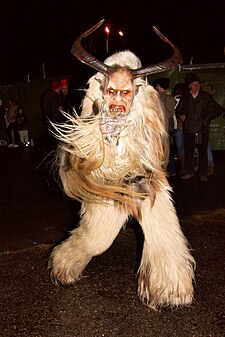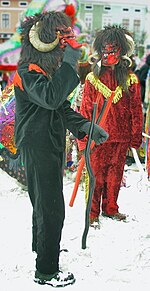Krampus is a beast-like creature from the folklore of Alpine countries thought to punish children during the Christmas season who had misbehaved, in contrast with Saint Nicholas, who rewards well-behaved ones with gifts. Krampus is said to capture particularly naughty children in his sack and carry them away to his lair.
Who Is Krampus? Explaining the Horrific Christmas Devil
The mythical Krampus is meant to whip children into being nice.

Merry—or not-so-merry—Krampus! This beast with Germanic roots is St. Nicholas’s other half and scares
children into being nice, not naughty.
PHOTOGRAPH BY SEAN GALLUP/GETTY IMAGES
Tanya Basu – National Geographic
PUBLISHED DECEMBER 17, 2013
Bad Santa, meet Krampus: a half-goat, half-demon, horrific beast who literally beats people into being nice and not naughty.
Krampus isn’t exactly the stuff of dreams: Bearing horns, dark hair, and fangs, the anti-St. Nicholas comes with a chain and bells that he lashes about, along with a bundle of birch sticks meant to swat naughty children. He then hauls the bad kids down to the underworld.
We wondered: What are the origins of this “Christmas Devil”?
Krampus, whose name is derived from the German word krampen, meaning claw, is said to be the son of Hell in Norse mythology. The legendary beast also shares characteristics with other scary, demonic creatures in Greek mythology, including satyrs and fauns.
The legend is part of a centuries-old Christmas tradition in Germany, where Christmas celebrations begin in early December.
Krampus was created as a counterpart to kindly St. Nicholas, who rewarded children with sweets. Krampus, in contrast, would swat “wicked” children and take them away to his lair.
According to folklore, Krampus purportedly shows up in towns the night before December 6, known as Krampusnacht, or Krampus Night. December 6 also happens to be Nikolaustag, or St. Nicholas Day, when German children look outside their door to see if the shoe or boot they’d left out the night before contains either presents (a reward for good behaviour) or a rod (bad behaviour).
A more modern take on the tradition in Austria, Germany, Hungary, Slovenia, and the Czech Republic involves drunken men dressed as devils, who take over the streets for a Krampuslauf—a Krampus Run of sorts, when people are chased through the streets by the “devils.”
Why scare children with a demonic, pagan monster? Maybe it’s a way for humans to get in touch with their animalistic side.
Such impulses may be about assuming “a dual personality,” according to António Carneiro, who spoke to National Geographic magazine earlier this year about revitalized pagan traditions. The person dressed as the beast “becomes mysterious,” he said.
Lump of Coal Preferred?
Krampus’s frightening presence was suppressed for many years—the Catholic Church forbade the raucous celebrations, and fascists in World War II Europe found Krampus despicable because it was considered a creation of the Social Democrats.
But Krampus is making a comeback now, thanks partly to a “bah, humbug” attitude in pop culture, with people searching for ways to celebrate the yuletide season in non-traditional ways. National Geographic has even published a book in German about the devilish Christmas beast.
In the U.S., people are buying into the trend with Krampus parties.Monday night’s episode of American Dad, called “Minstrel Krampus,” highlighted the growing movement of anti-Christmas celebrations.
For its part, Austria is attempting to commercialize the harsh persona of Krampus by selling chocolates, figurines, and collectible horns. So there are already complaints that Krampus is becoming too commercialized.
Looks like Santa might have some competition.
By Tanya Basu for National Geographic.
More Krampus Information from Wikipedia – Welcome Krampus to your festivities this year!
Krampus is a beast-like creature from the folklore of Alpine countries thought to punish children during the Christmas season who had misbehaved, in contrast with Saint Nicholas, who rewards well-behaved ones with gifts. Krampus is said to capture particularly naughty children in his sack and carry them away to his lair.
Krampus is represented as a beast-like creature, generally demonic in appearance. The creature has roots in Germanic folklore; however, its influence has spread far beyond German borders. Traditionally young men dress up as the Krampus in Austria, Romania, southern Bavaria, South Tyrol, northern Friuli,Czech Republic, Slovakia, Hungary, Slovenia and Croatia during the first week of December, particularly on the evening of 5 December (the eve of Saint Nicholas Day on many church calendars), and roam the streets frightening children with rusty chains and bells. Krampus is featured on holiday greeting cards called Krampuskarten. There are many names for Krampus, as well as many regional variations in portrayal and celebration.
Origins
Krampus at Morzger Pass in Salzburg
The history of the Krampus figure has been theorized as stretching back to pre-Christian traditions. In a brief article discussing the figure, published in 1958, Maurice Bruce wrote:
There seems to be little doubt as to his true identity for, in no other form is the full regalia of the Horned God of the Witches so well preserved. The birch—apart from its phallic significance—may have a connection with the initiation rites of certain witch-covens; rites which entailed binding and scourging as a form of mock-death. The chains could have been introduced in a Christian attempt to ‘bind the Devil’ but again they could be a remnant of pagan initiation rites.[1]
Discussing his observations while in Irdning, a small town in Styria in 1975, anthropologist John J. Honigmann wrote that:
The Saint Nicholas festival we are describing incorporates cultural elements widely distributed in Europe, in some cases going back to pre-Christian times. Nicholas himself became popular in Germany around the eleventh century. The feast dedicated to this patron of children is only one winter occasion in which children are the objects of special attention, others being Martinmas, the feast of the Holy Innocents, and New Year’s Day. Masked devils acting boisterously and making nuisances of themselves are known in Germany since at least the sixteenth century while animal masked devils combining dreadful-comic (schauriglustig) antics appeared in Medieval church plays. A large literature, much of it by European folklorists, bears on these subjects. … Austrians in the community we studied are quite aware of “heathen” elements being blended with Christian elements in the Saint Nicholas customs and in other traditional winter ceremonies. They believe Krampus derives from a pagan supernatural who was assimilated to the Christian devil.[2]
The Krampus figures persisted, and by the 17th century Krampus had been incorporated into Christian winter celebrations by pairing Krampus with St Nicholas.[3]
Countries of the former Habsburg Empire have largely borrowed the tradition of Krampus accompanying St Nicholas on 5 December from Austria.
Modern history
In the 20th century, Austrian governments discouraged the practice. In the aftermath of the 1934 Austrian Civil War, the Krampus tradition was prohibited by the Dollfuss regime[4] under the Fatherland’s Front (Vaterländische Front) and the Christian Social Party. In the 1950s, the government distributed pamphlets titled “Krampus is an Evil Man”.[5] Towards the end of the century, a popular resurgence of Krampus celebrations occurred and continues today.[6] There has been public debate in Austria in modern times about whether Krampus is appropriate for children.[7]
Appearance
Krampus parade in Pörtschach am Wörthersee (2013)
Although Krampus appears in many variations, most share some common physical characteristics. He is hairy, usually brown or black, and has the cloven hooves and horns of a goat. His long pointed tongue lolls out.[1][8]
Krampus carries chains, thought to symbolize the binding of the Devil by the Christian Church. He thrashes the chains for dramatic effect. The chains are sometimes accompanied with bells of various sizes.[9] Of more pagan origins are the ruten, bundles of birch branches that Krampus carries and occasionally swats children with.[1] The ruten have significance in pre-Christian pagan initiation rites.[1] The birch branches are replaced with a whip in some representations. Sometimes Krampus appears with a sack or a washtub strapped to his back; this is to cart off evil children for drowning, eating, or transport to Hell.[1]
Krampusnacht
A modern Krampus at the Perchtenlauf in Klagenfurt (2006)
The Feast of St. Nicholas is celebrated in parts of Europe on 6 December. In Alpine countries, Saint Nicholas has a devilish companion named Krampus[10] On the preceding evening, Krampus Night or Krampusnacht, the hairy devil appears on the streets. Sometimes accompanying St Nicholas and sometimes on his own, Krampus visits homes and businesses.[1] The Saint usually appears in the Eastern Rite vestments of a bishop, and he carries a ceremonial staff. Unlike North American versions of Santa Claus, in these celebrations Saint Nicholas concerns himself only with the good children, while Krampus is responsible for the bad. Nicholas dispenses gifts, while Krampus supplies coal and the ruten bundles.[11]
Krampuslaufen
A Krampuslauf is a run of celebrants dressed as the beast, often fueled by alcohol. It is customary to offer a Krampus schnapps, a strong distilled fruit brandy.[1] These runs may includeperchten, similarly wild pagan spirits of Germanic folklore and sometimes female in representation, although the perchten are properly associated with the period between winter solsticeand 6 January.
Krampuskarten
Regional variations
Krampus appears in various forms, and as part of differing celebrations, throughout central Europe. In Styria, the ruten bundles are presented by Krampus to families. The twigs are painted gold and displayed year-round in the house—a reminder to any child who has temporarily forgotten Krampus. In smaller, more isolated villages, the character has other beastly companions, such as the antlered “wild man” figures, and St Nicholas is nowhere to be seen. These Styrian companions of Krampus are calledSchabmänner or Rauhen.[1]
A toned-down version is part of the popular Christmas markets in Austrian urban centres like Salzburg. In these, more tourist-friendly interpretations, Krampus is more humorous than fearsome.[14]
In the 1600s, the Lutheran Church presented a “christchild” figure in the place of the Catholic Saint Nicholas. Representing the baby Jesus but often appearing as a young maiden, this figure was also paired with Krampus in some areas. In France’s Alsace region, Krampus is known as Hans Trapp and accompanies a “christchild” character during the holiday season.[11]
North American Krampus celebrations, though rare, are a growing phenomenon.[15] Some traditional Germanic communities in the north-east of the United States have preserved a Krampus tradition; in these he goes by Bellsnichol and combines aspects of both the wild man and Saint Nicholas.[11]
Other names
Outside of krampus, the being has many names. Klaubauf is used throughout Austria, while Bartl or Bartel, Niglobartl, and Wubartl are used in the southern part of the country.[1][16] Outside Austria, Krampus and related creatures go by Pelzebock or Pelznickel in southern Germany, and Gumphinckel in Silesia.[17] In Hungary, he is Krampusz (often used to refer to the entire race of these creatures),[3] and in Switzerland, Schmutzli.[18]
Popular culture
Krampus appeared in the American Dad! episode “Minstrel Krampus” voiced by Danny Glover. The show was cited by National Geographic as one of the manifestations of a growing anti-Christmas sentiment in the country.[19]
TAKEN FROM WIKIPEDIA





